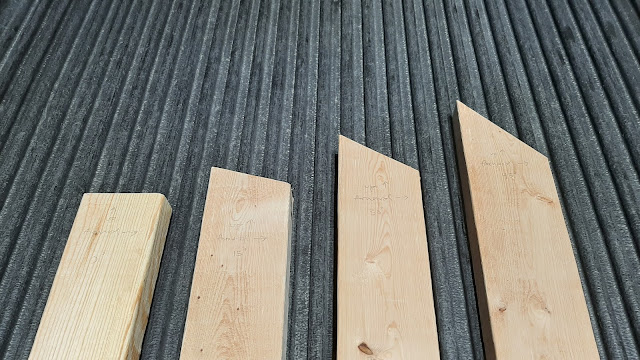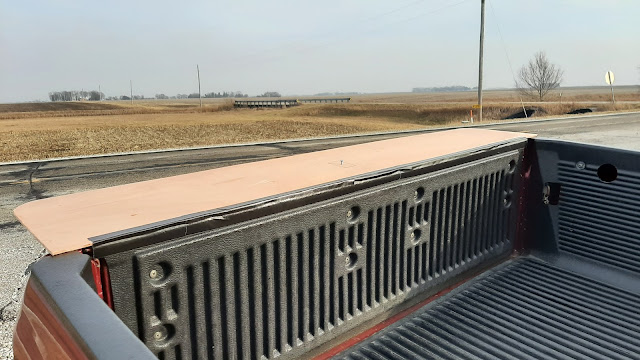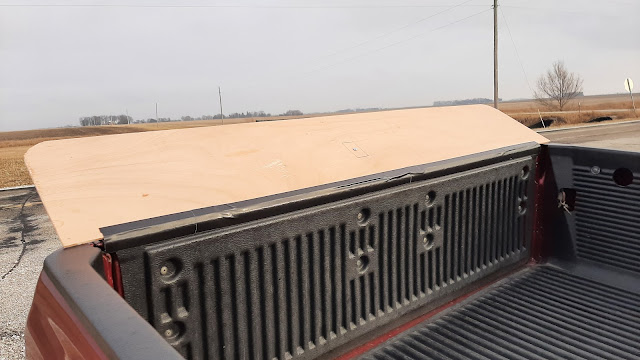This brings my truck’s aerodynamic drag down to around 84-85%
of what it was before I started this project:
|
Modification
|
Percent Change
|
|
mirrors removed,
grill blocked
|
-4.0%
|
|
9” air dam
|
-8.6%
|
|
air dam extensions
|
-3.8%
|
|
Total
|
-16.4%
|
I didn’t expect to get that much with these changes,
especially because I haven’t even tested anything on or around the bed, rear
undercarriage, tailgate, rear wheel housings, or rear bumper.
Tailgate
Many websites claim that lowering a truck’s
tailgate increases its drag. This was even explored on an episode of the
popular television show Mythbusters; the show’s hosts put a model truck
in a water tunnel to illustrate the recirculation that happens in the bed (and
ran some fuel economy tests with the tailgate down, removed, and replaced with
mesh). You can see this recirculation if you tape tufts to your truck’s bed
floor, like I did a while back:


The tufts generally point forward—showing that flow along
the bed floor is moving forward. And, although it seems counterintuitive, this
happens with the tailgate lowered as well. Notice the tufts on the gate
itself in the images above; they still point sideways/forward when the gate is
down, not out the back.
What does this mean for drag, though? Well, that isn’t clear
from the tufts. I’ll use a throttle-stop test to see if
there’s a change in drag associated with lowering the tailgate on my truck. I
expect there will be; one study on production trucks found as much as a 5%
increase from putting the tailgate down, on a second-generation Ford Ranger.
Spoiler
Less clear, though, is what effect adding a spoiler to the
tailgate will have on drag. Twenty years ago, truck tailgates didn’t have any
sort of elongation on their top edge. Starting with truck redesigns after the
turn of the millennium, flat spoilers began to be molded into the sheet metal
of the tailgate with a plastic cap added to the top of it. On the current
generation of trucks, these tailgate spoilers are generally a few inches long,
rounded (longer in the center than at the edges), and may have an additional
short, vertical flap:
 |
| 2022 Chevrolet Silverado. The Silverado has a short flap in the center of the tailgate. |
 |
| 2022 Ford Maverick. The Maverick's flap extends almost the full width of the tailgate. |
 |
| 2022 Toyota Tacoma. The Tacoma has no flap... |
 |
| ...while the 2022 Tundra has a flap similar to the Silverado's. |
I suspect that any change in drag on my truck won’t be
measurable if I mock up a spoiler similar in size to these because they’re so
small. Since I’m not constrained by any total length requirements (believe it
or not, this truck is a few inches shorter than my Prius. Remember when
compact trucks were actually compact?), I decided to use a 10” long plywood
board for testing. I used some scrap 2”x4” to cut supports to hold the spoiler
at four progressively steeper angles:
I’ll test at 0°, 15°, 30°, and 45°.
If you’re investigating an easily-changed parameter such as this, test it in a
range of positions; this will be more informative than picking a single one
since it will show how an aerodynamic characteristic (in this case, drag)
changes with the parameter (spoiler angle)—real-world differential calculus!
The board will be screwed to each support and everything
taped down with Gorilla tape to hold it in place for testing.
What will these do? I suspect that the steep spoiler:
…will increase drag. The lower angles and flat spoiler? No
idea; hopefully they'll reduce drag. Let’s find out.
Results
|
Configuration
|
Speed
|
% Change
|
% Change
(corrected)
|
|
standard
|
93 kph
|
0.0%
|
0.0%
|
|
tailgate down
|
91 kph
|
+4.3%
|
+3.6%
|
|
0°
spoiler
|
91 kph
|
+4.3%
|
+3.6%
|
|
15°
spoiler
|
91 kph
|
+4.3%
|
+3.6%
|
|
30°
spoiler
|
89 kph
|
+8.4%
|
+7.0%
|
|
45°
spoiler
|
88 kph
|
+10.5%
|
+8.8%
|
Analysis
Turns out, I’ve saved myself a lot of time designing and
building a permanent spoiler right now—because all of these increased drag! Even the flat
spoiler, which surprises me. Given the prevalence of flat tailgate spoilers on
production trucks, I thought this might work to decrease the drag of my truck.
What gives?
Well, perhaps the optimum drag-reducing spoiler on a truck
with an open bed is shorter than what I tested. Perhaps the dimensions and
shape of the bed, bed sides, and side rails affect spoiler performance. Perhaps
the shape of the roof and cab height matter. Perhaps the shape of the tailgate
itself and rear bumper affect things. Perhaps the underside of the truck and
the bumper height from the ground influence the spoiler. Who knows? Any one or
a combination of these things (and more) might affect what a spoiler of this size
did on my truck, and they are all parameters I can investigate through further testing.
Since I tested at a range of angles, I have a pretty good idea now what a spoiler this size does as its angle from horizontal increases. Plotting drag change versus spoiler angle makes this clearer:
The shallower angles don't really change in how much they increase drag over no spoiler; as the angle steepens, the change in drag per change in angle increases and then starts to taper off as it approaches 45°. In mathematical terms:
This is all "differential calculus" is, fundamentally: relating rates of change.
Any time you have an opportunity to discover relationships like this in your testing, use it! If I find in future tests that, say, the steep spoiler reduces lift and I want to build a permanent version, I will already know its effect on drag. All that knowledge cost me was a little time.





















So how about a tourneo cover or an aerodynamic camper shell?
ReplyDeleteGreat read, I really enjoyed this. Thank you.
ReplyDeleteWould probably be WAY better if combined with a tonneau cover.
ReplyDeleteI'm considering doing some aerodynamic mods to my truck, I'd be building an air dam for my truck and I'd be using a bristled mud flap as it will allow you to preserve your ground clearance; thought I should mention it as a good route for anyone trying to build one.
ReplyDeleteYou need to create a airfoil shape folding fabric-on-wooden frame to cover the bed and even create an additional whale tail beyond the bed rear
ReplyDeleteThat will fix the drag as convertibles and pick up beds create a lot of turbulence
Thank you for showing the front spoiler hack, it looks like some solar vehicles drag reduction
I think for the spoiler it should be angled down. Down because it will reduce the wake and there's a forward pushing component the air will have on your car assisting it in moving.
ReplyDelete